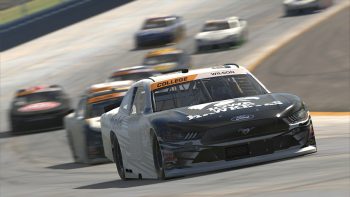
NASCAR iRacing Series Open Garage: Michigan (again)
August 13th, 2014 by JaimeB
Returning to Michigan International Speedway this week gives us an opportunity to take a look at methods for improving a setup when making a return visit to a track. Rarely — if ever — will a setup be so good that it can be used on every visit to a given track without making minor changes. You will find differing weather conditions, simulator updates and even a developing driver’s change in style will affect the handling of the car enough to require the crew chief adapt the setup to the current conditions.
Much like the setup folder in the simulator, most crew chiefs keep a detailed set of “Setup Sheets” or notes they take each week. These notes include critical information on the current chassis setup such as weather conditions, track temperature, tire temperatures, tire wear, fuel use and how the car feels to the driver.
These “Setup Sheets” are usually considered trade secrets and are only accessible to the crew chief, car owner and car chief. Some teams however, like we here in the Open Garage, are more open to sharing. I encourage you to take your own notes and to save multiple versions of the setups based on the conditions. Printable blank setup and tire information sheets are available in our iRacing forum.
One way I like to name my setups is to include the track temperature in the title. For example if the temperature is 84* I will name the setup NiS_MichRace84 or NiS_MichQual84. This will give me a good starting point when returning on a day with similar weather conditions. Providing that there have been no major changes to the simulator, your gear, grill tape and handling should be at a comparable starting point from which you can base your initial adjustments.
When returning to a track make a note of the track temperature that day so that when you load your setup you may make adjustments, if needed, to the grill tape and the gear ratio to prevent overheating on the initial laps. Take the car out for 20-30 laps to re-familiarize yourself with the track and to make sure you have the car at operating temperature. You may want a more conservative tape setting on tracks where the draft of traffic can reduce the amount of airflow over the radiator. In any respect you will want to keep you water beneath 130*c and your oil under 135*c to prevent damage to the engine.
“Rarely — if ever — will a setup be so good that it can be used on every visit to a given track without making minor changes.”
This week we developed a push on entry which gives me a chance to discuss one of my favorite ways to improve handling in separate parts of the turn. Shock absorbers dampen the suspension movement of a vehicle when the suspension is moving in the car to improve handling.
For example, when entering a corner at a high speed high-banked course the body is forced down towards the pavement, pushing the tires into the wheel well. This is referred to as “compression.” When exiting a corner the “rebound” affects the forces pushing the body away from the tires. As the shock shaft moves within the shock body, oil is forced through openings in the piston to push against the “shim” stack on the opposite side. Finally, “packers” are used to control the height at which the bump stop sits, which alters the timing and engagement points of the shock.
While too limited in space to go into full detail, I will give you a breakdown of how to make adjustments this week to the shock to control each part of the corner:
In the Left Front: Positive Bump = Loosen Entry, Negative Bump= Tighten Entry, Positive Rebound= Loosen Exit, Negative Rebound = Tighten Exit.
In the Right Front: Positive Bump = Tighten Entry, Negative Bump = Loosen Entry, Positive Rebound = Tighten Exit, Negative Rebound = Tighten Exit
In the Left Rear: Positive Bump = Tighten Exit, Negative Bump = Loosen Exit, Positive Rebound = Loosen Entry, Negative Rebound = Tighten Entry
In the Right Rear: Positive Bump = Loosen Exit, Negative Bump= Tighten Exit, Positive Rebound= Loosen Exit, Negative Rebound = Tighten Exit
This week I reduced the amount of bump in the right front shock to free-up the car on entry. I also added 10% more grill tape to increase our operating temperatures. We noted an increase of .50 seconds in lap times with no additional wear, which is a considerable improvement of our previous visit.
For some additional speed, try watching your replay from the wheel view to see if there is any room to lower the chassis.
Good Luck and God Speed!
















































